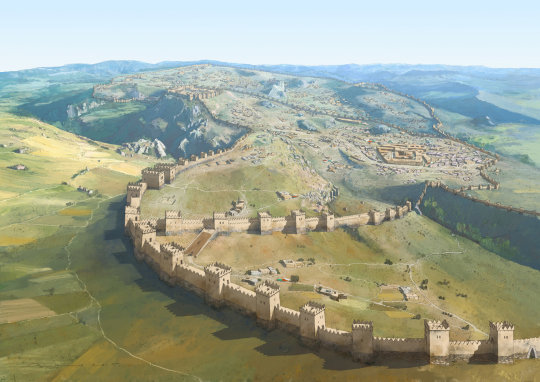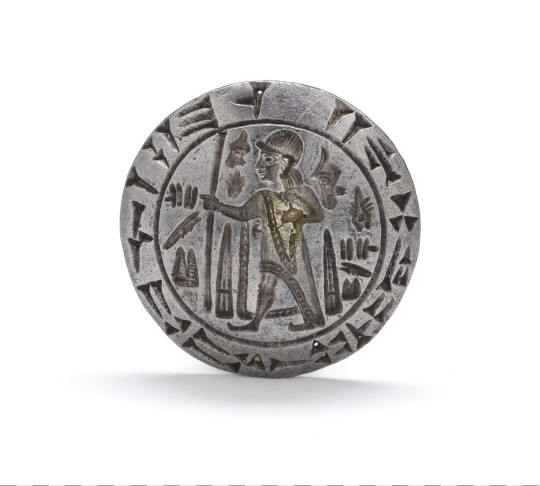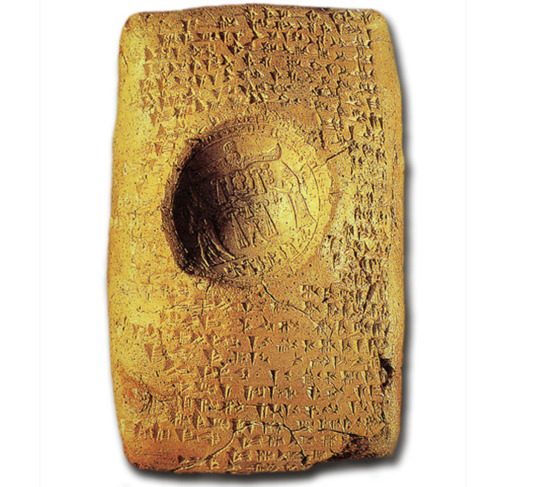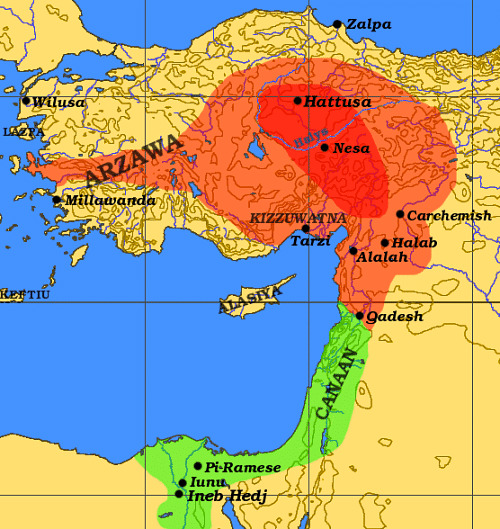#Hittite
Explore tagged Tumblr posts
Text

Capital of the Hittite Empire between 1420 and 1200 BC. Hattusa now lies in ruins beside Boğazkale, Turkey. Learn more / Daha fazlası https://www.archaeologs.com/w/hattusas/
#archaeologs#archaeology#archaeological#history#dictionary#art#hittite#hittite empire#hattusa#hattusas#illustration#hattuşa#arkeoloji#tarih#sanat#hitit#hitit imparatorluğu
98 notes
·
View notes
Text

Silver rhyton in the form of a bull, Hittite, 14th-13th century BC
from The Metropolitan Museum of Art
395 notes
·
View notes
Text

vessel terminating in the forepart of a stag | c. 14th-13th century BCE | hittite
in the met museum collection
195 notes
·
View notes
Text

Illuyanka, the 248th Known One.
#Illuyanka#Hittite#mythology#dragon#smaugust#snake#its related to hydras and typhon etc so im forshadowing those designs here with the segments made of multiple eels#eel#Proto-Indo-European#992#octem 124#aer 4#Anatolia#Turkey#the Known Ones
290 notes
·
View notes
Text

Seal of Tarkasnawa, King of Mira
Hittite, Anatolia, late 13th century BCE (Hittite Empire)
Luwian hieroglyphs surround a figure in royal dress. The inscription, repeated in cuneiform around the rim, gives the seal owner's name: Tarkasnawa, king of Mira. The name of the ruler was previously transliterated into English as Tarkondemos and Tarkummuwa. Other inscriptions naming Tarkasnawa of Mira are known, including seals found at Hattusa (the capital of the Hittite Empire) and the Karabel rock relief carving near Izmir, Turkey. Located in west-central Anatolia, Mira was a vassal state of the Hittite Empire. This seal, originally published in the 1860s, was purchased in Izmir by its first known modern owner, A. Jovanoff. Its famous bilingual inscription provided the first clues for deciphering Luwian hieroglyphs, which were previously called Hittite hieroglyphs.
241 notes
·
View notes
Text

“Horse Rock,” Beyşehir, Konya Province, Anatolia, Turkey,
The Tomb of Lukuyanus from 2000 years ago, is dedicated to a beloved jockey who was likely buried in the “grave room”, a small chamber next to the horse relief with a columned entrance.
The grave room is devoid of remains now so we don’t know much about Lukuyanus other than what’s on the inscription: “Lukuyanus The Warrior, Died Before Getting Married. He is Our Hero.”
Since he died before marriage, he was likely a young man when he met his end, but he lived long enough and had enough success on the track to earn him dedicated fans who built him such a handsome and on-topic final resting place.
Fan-funded funerary monuments for sports heroes have proved rich sources of historical information before.
The monument is near the site of an ancient hippodrome in mountains that were sacred to the Hittites. The Romans may even have built a hippodrome on this spot to bless and be blessed by the Hittites’ holy hills.
#art#history#design#style#archeology#sculpture#antiquity#jockey#hero#tomb#grave#turkey#warrior#hittite#lukuyanus#monument
108 notes
·
View notes
Text


Classicstober Day 14: Helen (𐀁𐀩𐀛/𒄭𒇷𒉌)
Helen of Troy… Helen Queen of Sparta… Helen Princess of Sparta… Helen the daughter of Leda and Zeus… the face that launched a thousand ships wore many masks over the course of her life but one thing that remains the same is how compelling she remains as a character. Many thanks to @symeona for helping me with her look!
Helen is a character intrinsically associated with her appearance, but early sources do not describe her at all outside of demonstrations of her status. For this piece, I have borrowed from two sources. The first is symeona, who's excellent translations on Ancient Greek color theory informed my take on Achilles. The second was that wretched and accursed fnckboy Ovid, who described Helen's mother Leda as having 'snowy white' skin and black hair. Since Zeus appeared to Leda in the form of a swan, and considering how pale Leda was, I decided to make her somewhat swan-like in appearance, with big black eyes and naturally ruddy lips to seal the deal.
First, let's talk about Helen the Spartan (rendered here in Linear B as 'Eleni of Laconia'). Despite mainly being known for her role in the Trojan War, Helen lived the majority of her life in Sparta and her husband Menelaus claimed the throne of Sparta through her. Laconia and Sparta are some of the oldest sites of Mycenaean culture, so Helen got to be depicted as Mycenaean as all getout. The high-piled hair, the diadem, the open tunic, and the bracelet are all very common in depictions of Mycenaean and Minoan women. She also has very elaborate florets to mark her status. The red fabric and large gemstones mark her wealth too i completely forgot to draw in the necklace she wore in the sketch version.
I mentioned before in my picture of Cassandra and Hector that I am basing the Trojan looks heavily on ancient Hittite clothing, and this is no exception. I know the movie Troy sucks for lots of reasons, but I did like that they made the Trojan theme color this very rich blue so I decided to add that here; dark, rich colors in general are very expensive to produce, so even if it's not red the saturation makes the cloth very expensive and a mark of royalty. I based her clothing and jewelry off a Hittite statue, but I decided to omit the tall hats that Hittite women appear to wear under their veils; I kind of wanted that to represent status, so only Andromache and Hecuba would wear the tall hats if I depict them.
I was not trying to make a commentary with it, but it does strike me how conservative the veiled, tunic wearing Hittite woman looks compared to the open-bodiced Mycenaean woman. That could easily be read into, but I'm just going to leave it as depiction and not try to ascribe any symbolism to it.
The decorative circle around Helen represents several things. Horses feature prominently in her life. The Trojan Horse is the most well known, but the wedding oath that Tyndareus made Helen's suitors swear to was sealed with the sacrifice of a horse too. Anemones are a sacred flower to Aphrodite (long story) and the white lilies seem like a fun way to evoke the 'pure woman' image.
Also in the circle are depictions of Eris' golden Apple of Discord. For the life of me, I could not find any translation related to fairness or beauty in any Mycenaean dictionaries so I had to cheat: "𐀴 𐀏𐀪𐀯𐀳𐀂/ti ka-ri-se-te-i" is just a phonetic transliteration of ΤΗΙ ΚΑΛΛΙΣΤΗΙ (tē(i) kallistē(i)), translated as 'for the fairest.'
#classicstober#classicstober2023#classicstober23#helen of troy#helen of sparta#greek mythology#ancient greek mythology#tagamemnon#linear b#mycenaean#hittite#hittite cuneiform#cuneiform
190 notes
·
View notes
Text

I am convinced that the bronze age collapse caused by the Nälkä as sea peoples was because the Hittites got the copper for their bronze weaponry from Ea-nāṣir Klavigar Orok and Karcist Halyna Ieva artwork by Niram: https://scp-wiki.wikidot.com/niram-art
28 notes
·
View notes
Text


Divorce-Writ of King Ammistamru II Ugarit, Syria c. 1250 BCE A tablet documenting the divorce of King Ammistamru II of Ugarit fromhattusa the daughter of the Amorite king Benteshina, sealed by the Hittite King Ammistamru. The king stands to the right, holding a spear, next to the "Weather God" who holds a club. They are both facing a long-robed female goddess (Arima, the chief Hittite sun-goddess) who stands at the left. Source: Virtual Museum of Syria
#ugarit#hittite#baal#hadad#ugaritic costume#arima#sun goddess#huttusa#hittite gods#canaan#canaanite gods#phoenicia#phoenician gods#aram#aramean gods#syria#syrian gods#levantine gods#mesopotamia#mesopotamian gods#pagan gods#polytheism#archeology#magic#witchcraft#witchblr#paganblr#occult
286 notes
·
View notes
Photo

Kaskians
The Kaska or Kaskians were a tribe of the Pontus, northern Anatolia (today's Turkey), around the Kizil Irmak river mouth, bordering on and constantly harrasing the Hittite empire. That area is mostly mountainous in nature, and there the Kaska occupied simple settlements which presumably formed a loose confederation.
The first recorded appearance of the Kaska in history was during the reign of Hantili I (c. 1590 BCE - 1560 BCE), when they conquered territory including the holy city of Nerik. The city could not be put back under Hittite control until two centuries later.
The Kaska repeatedly penetrated Hittite lands, but never with a permanent occupation, except for the area around Nerik city, which was the gateway between Kaskan and Hittite territories. During Tudhaliya's reign, a major Kaska invasion -maybe concurrently with attacks from other Hittite enemies - led to the brief occupation of the Hittite's capital city, Hattusa, which was burned to the ground (c. 1380 BCE).
The Hittites in turn directed many punitive campaigns against the Kaska territory throughout their history, never being able to subjugate the area. Much of Mursili II's reign (c. 1321 BCE - 1295 BCE), one of the Hittite's greatest kings, was devoted to campaigns against the Kaska. Mursili stated that in his time there was a Kaskan leader called Pihhuniya who acted as king of the Kaska, something never seen before in Kaskan affairs. Occasionally the Hittites and the Kaska chiefs were able to settle treaties of peaceful coexistence, as was the case under Hittite king Arnuwanda I.
The Kaska joined other invaders from afar, the Sea Peoples and the Phrygians, in the final collapse of the Hittie empire c. 1200 BCE. After that, and since Hittite records are our main source about the Kaska, we lose track of them; they fade away as the general political and ethnic landscape in Anatolia changed. They are, however, referenced in the neighbouring Assyrian empire somewhat later, who's king Tiglath-Pileser (c. 1112 BCE - 1072 BCE) fought against Kaskan forces. The last reference to the Kaska comes from the time of the Assyrian king Sargon II around 700 BCE, who also fought them.
Continue reading...
43 notes
·
View notes
Text

Hittite warband done
23 notes
·
View notes
Text

Painting I made from around 1.5 years ago, depiting an elite warrior from the ancient Hittite Empire that ruled Anatolia and parts of the middle east. Hope you like it!
Best,
JCH
#dungeons and dragons#board games#concept art#fantasy art#tabletop games#digital painting#magic the gathering#character design#ancient history#armor#ancient egypt#hittite#babylon#assyria#persia
101 notes
·
View notes
Text

Silver rhyton in the form of a stag, Hittite, circa 1700 BC
from The Metropolitan Museum of Art
484 notes
·
View notes
Text

stag poletop | c. 1400-1200 BCE | hittite, modern-day turkiye
in the cleveland museum of art collection
115 notes
·
View notes
Text

Reggie, the hittite priestess
I've been watching AoE1 speedruns and I thought this was a pretty funny idea
10 notes
·
View notes
Text

Orthostat Relief: Lion-Hunt Scene
Syria, Hittite, 10th−9th century BCE
243 notes
·
View notes